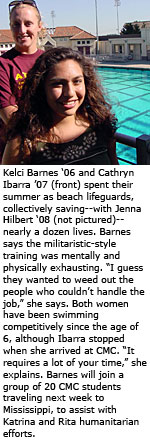 When Professor Ed Haley, the W.M. Keck Foundation Chair of International Strategic Studies, recently queried students in his Government 149 Foreign Relations of the United States class about how they spent summer break, he expected a round of internship fast-tracking and foreign travel responses. What he got was a grudging admission of life-saving heroics on the part of three students who spent their summer as lifeguards at local beaches and swimming holes.
When Professor Ed Haley, the W.M. Keck Foundation Chair of International Strategic Studies, recently queried students in his Government 149 Foreign Relations of the United States class about how they spent summer break, he expected a round of internship fast-tracking and foreign travel responses. What he got was a grudging admission of life-saving heroics on the part of three students who spent their summer as lifeguards at local beaches and swimming holes.
The women, Kelci Barnes '06, Cathryn Ibarra '07, and Jenna Hilbert '08, saved a collective 11 lives during their time off from CMC, and each, modestly, chalks it up to being just part of the job.
"What stunned me and impressed me deeply was that these three women said they had summer jobs as lifeguards but didn't volunteer that they had rescued anybody," Haley says. "In fact, I had to ask each of them. When I did, they downplayed it. None of the three seemed to realize what a big deal it really is."
For Barnes, who was certified in May 2003 by the Los Angeles County Ocean Lifeguard division of the fire department, one particular day stands out in memory.
"Last spring I took advantage of a three-day weekend from my studies at CMC to work a bit at Santa Monica Beach," says Barnes, a competitive swimmer since the age of 6 and a member of the CMS varsity swim and water polo teams. "That Sunday, it seemed everyone in the entire state descended, and the rip currents were as powerful as small rivers. I didn't even manage to complete my opening procedure in the tower before the rescues started, and I didn't sit down until nearly seven hours later. I think I rescued about 25 people that day. When I finally was able to take a break that day and unclench my jaw, I was exhilarated. Everyone who came to the beach left the beach."
According to Ibarra, who was Red Cross-certified at the age of 15 at a Girl Scout facility in Seabrook, Texas, like anything else the first time you do it, the ability to save lives builds confidence toward accomplishing the next rescue.
"I am more aware of how careless people can be at times, and how dangerous a seemingly harmless situation can become in a matter of seconds," says Ibarra, wholike Barnes started swimming competitively in first grade. "It is fulfilling though, in a way, to know that someone is still alive because of something I did. As a lifeguard, I'm supposed to prevent dangerous situations from occurring. However, things sometimes happen that you can't prevent. Those are the rescues that impact me most.
"I guess you could say that I am more aware of the fragility of life because I have seen how quickly and how little it takes for it to be threatened," she said.
CMS head swimming coach Charlie Griffiths says there are inherent differences between life-guarding at a beach and standing watch at a pool, which offers a more controlled environment without the added challenges of currents, wildlife, or sudden changes in depth. But both forms, he says, require equal measures of vigilance. "A lifeguard's primary responsibility always is to maintain a safe environment and to be ready to respond to an emergency."
Haley says that while discussing summer life-guarding with Barnes, Ibarra, and Hilbert, he asked the women if the parents of those they rescuedor the rescued, themselves had given them presents or taken them out to dinner. Their answer, he says: "We're not allowed to accept gifts."
"I love the combination of achievement and modesty," Haley says. "These women are brave, strong, and skilled."
CMC Lifeguards Spend Busy Summer
Topics
Contact
Office of Strategic Communications & Marketing
400 N. Claremont Blvd.
Claremont, CA 91711
Phone: (909) 621-8099
Email: communications@cmc.edu
Media inquiries: CMC Media
Email: media@cmc.edu
